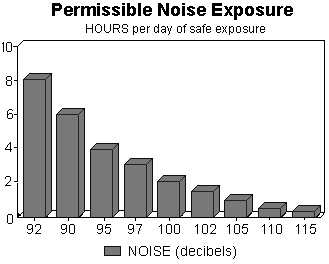That dull, ringing sensation in your ears after a long day on the tractor is an indication that you have exceeded a sound level that can be comfortably tolerated. Ringing in the ears could be the first sign of hearing loss.
This ringing is typically accompanied with a slight loss of hearing where faint sounds that are normally heard are no longer detectable. While overnight rest will generally restore normal hearing, repeated, prolonged exposure to noise of this intensity will likely result in a permanent hearing loss.
CALCULATING NOISE EXPOSURE
For instance, the decibel level inside an acoustically-insulated tractor cab performing typical field operations is 85 decibels (see Table 1). At this sound level, there is no threat of hearing damage for most individuals, regardless of the length of time in the cab. But, take off the cab, let corrosion deteriorate the exhaust system, and now this same tractor is producing 100 decibels. These 15 additional decibels limits safe operation to two hours before the threat of hearing damage becomes an issue. Older tractors without cabs frequently produce sound levels that allow less than eight hours of exposure before noise induced hearing loss is a problem.
| 0 | Acute threshold of hearing |
| 15 | Average threshold of hearing |
| 20 | Whisper |
| 30 | Leaves rustling, very soft music |
| 40 | Average residence |
| 60 | Normal speech, background music |
| 70 | Noisy office, inside auto at 60 mph |
| 80 | Heavy traffic, window air-cond. |
| 85 | Inside acoustically insulated protective tractor cab in field |
| 90 | OSHA limit - hearing damage on excess exposure to noise above 90 dB |
| 100 | Noisy tractor, power mower, ATV, snowmobile, motorcycle |
| 120 | Thunder clap, jack-hammer, basketball crowd, amplified rock music |
| 140 | Threshold of pain - shot gun, near jet taking off, 5- hp siren (100') |
In many instances, it is not possible to reduce tractor or
equipment noises below the safe 85 decibel limit established
by the National Institute for Occupational Safety and Health,
a federal government research agency. In these situations,
the only choice is to use ear plugs or earmuffs.
Disposable ear plugs are the least expensive method of ear protection. Quantity discount prices begin at 15 cents a pair. Earmuff prices begin at about $10.
These protective devices have a noise reduction rating (NRR) which is an indicator of how many decibels a hearing protector reduces noise.
Ear plugs have an NRR ranging from 26 to 31; most earmuffs have a NRR ranging from 23 or more. In the example of a tractor producing 100 decibels, an operator wearing ear plugs can reduce his or her noise level exposure to less than 80 decibels.
Noise induced hearing loss knows no age discrimination; older workers as well as teenagers have suffered hearing loss from farm-related activities. Even workers who have suffered some hearing loss can save what they have left with consistent use of ear plugs or muffs when working around noisy equipment.
"If you can't reduce the noise level of machinery, block it out with hearing protection devices" is sound advice for anyone working around noisy equipment. In addition to wearing ear protection, the following recommendations will help keep noise levels down:
Blocking noise can lower the potential for hearing losses. This includes simple machinery maintenance techniques such as keeping all equipment well-lubricated, properly adjusted, and maintained. Maintenance can increase the lifespan of equipment, reduce down time, create safer working conditions, and can reduce noise.
Limit exposure to the noise. The risk of hearing damage increases with the amount of time spent in a noisy area. Limiting the amount of time spent in a noisy area reduces the risk of hearing damage. If you can't reduce exposure, wear earmuffs or rated ear plugs. Cotton makes a great T-shirt, but it is ineffective as ear plugs.
When working in a shop, keep as much distance between you and noisy equipment. Locate a noisy air compressor or other shop equipment as far away from the work area as possible. Doubling the distance from the source of a noise reduces the sound level by one-fourth (1/4). An acoustic barrier, made out of fire resistant material, could also reduce the noise level in a shop.
When purchasing new equipment, consider the noise output level of the machine. The additional cost of purchasing a tractor with a cab may be outweighed by the increased benefits of reduced noise and operator comforts. Sound levels inside the cab of a new tractor are often listed in the manufacturer's literature. Lowering noise levels in the tractor cab is an indication of quality construction for "comfort of the operator" and can avoid hearing loss.
This information is for educational purposes only. Reference to commercial products or trade names does not imply endorsement by the Cooperative Extension Service or bias against those not mentioned. Cooperative Extension Service programs are open to all without regard to race, color, national origin, sex or handicap. MSU is an Affirmative Action/Equal Opportunity Institution.
Disclaimer and Reproduction Information: Information in NASD does not represent NIOSH policy. Information included in NASD appears by permission of the author and/or copyright holder. More